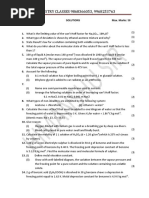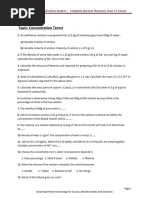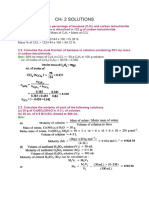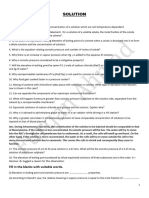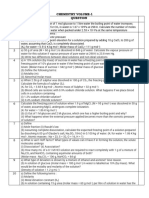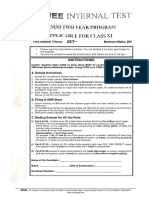Solutions QP
Solutions QP
Uploaded by
clutchforever999Copyright:
Available Formats
Solutions QP
Solutions QP
Uploaded by
clutchforever999Copyright
Available Formats
Share this document
Did you find this document useful?
Is this content inappropriate?
Copyright:
Available Formats
Solutions QP
Solutions QP
Uploaded by
clutchforever999Copyright:
Available Formats
REVISION TEST-2-PA-3
CHEMISTRY
CLASS XII - SOLUTIONS Max Marks : 30
Time : 1 Hr
1. The molecular masses of polymers are determined by osmotic pressure method and nor by 2
measuring other colligative properties. Give two reasons.
2. Define the following terms: 2
(i) Mole fraction
(ii) Isotonic solutions
(iii) van’t Hoff factor
(iv) Ideal solution
3. How is vapour pressure of solvent affected when a non volatile solute is dissolved in it? 2
4. A solution is prepared by dissolving 10 g of non-volatile solute in 200 g of water. It has a vapour 2
pressure of 31.84 mm Hg at 308 K. Calculate the molar mass of the solute. (Vapour pressure of
pure water at 308 K = 32 mm Hg)
5. 18 g of glucose, C6H12O6, is dissolved in 1 kg of water in a saucepan. At what temperature will 2
water boil at 1.103 bar? (Kb for H2O is 0.52 k kg mol–1)
6. Some ethylene glycol, HOCH2—CH2OH is added to your car’s cooling system along with 5 kg of 3
water. If the freezing point of water glycol solution is –15 °C, what is the boiling point of the
solution? [Kb = 0.52 K kg mol–1, Kf = 1.86 K kg mol–1]
7. What would be the molar mass of a compound if 6.21 g of it dissolved in 24.0 g of chloroform 3
forms a solution that has a boiling point of 68.04 °C. The boiling point of pure chloroform is 61.7 °C
and the boiling point elevation constant, Kb for chloroform is 3.63 °C/m.
8. 3.9 g of Benzoic acid dissolved in 49 g of benzene shows a depression in freezing point of 1.62 3
K. Calculate the van’t Hoff factor and predict the nature of solute (associated or dissociated).
(Given; Molar mass of benzoic acid = 122 g mol–1, Kf for benzene = 4.9 K kg mol–1)
9. What is the molality of ammonia in a solution containing 0.85 g of NH3 in 100 mL of a liquid of 3
density 0.85 g cm–3?
10. The Henry’s Law constant for oxygen dissolved in water is 4.34×104 atm at 25 °C. If the partial 3
pressure of oxygen in air is 0.2 atm, calculate the solubility of oxygen in water at 25 °C.
11. (a) Explain the following: 5
(i) Henry’s law about dissolution of a gas in a liquid.
(ii) Boiling point elevation constant for a solvent.
(b) A solution of glycerol (C3H8O3) in water was prepared by dissolving some glycerol in 500 g of
water. This solution has a boiling point of 100.42 °C. What mass of glycerol was dissolved to make
this solution? (Kb for water = 0.512 K kg mol–1)
1/2
You might also like
- Solved Problems in SEC by Mark Guimba PDFDocument138 pagesSolved Problems in SEC by Mark Guimba PDFRayyan100% (1)
- Scherrer Quantum Physics Solutions Chapter 1Document9 pagesScherrer Quantum Physics Solutions Chapter 1AATroop0% (1)
- Solutions MSDocument4 pagesSolutions MSclutchforever999No ratings yet
- Xii Cbse Solution Numerical KeyDocument11 pagesXii Cbse Solution Numerical KeymahbathuallahNo ratings yet
- 11 Chemistry Unit 9 Queston PaperDocument3 pages11 Chemistry Unit 9 Queston PaperNandhakumar NANDYNo ratings yet
- Unit 2 Solution Imp QuestionsDocument2 pagesUnit 2 Solution Imp QuestionsManprit SinghNo ratings yet
- CHEMISTRY - SOLUTIONSDocument5 pagesCHEMISTRY - SOLUTIONSabhishekraibagi69No ratings yet
- Class 12 (Solution Chapter) HSC PYQsDocument2 pagesClass 12 (Solution Chapter) HSC PYQspriyanka deshmukhNo ratings yet
- PrintDocument4 pagesPrintSamarpita BeheraNo ratings yet
- SolutionDocument9 pagesSolutionanshumanpanda7735No ratings yet
- Chapter 2 SolutionsDocument2 pagesChapter 2 SolutionsAaryaNo ratings yet
- Class-12 Chemistry Summer Holidy Home Work - 2024Document11 pagesClass-12 Chemistry Summer Holidy Home Work - 2024siddharthatejshvi217No ratings yet
- Xii Chemistry - CH 02 - Solutions - Question BankDocument12 pagesXii Chemistry - CH 02 - Solutions - Question BankBUNNY GOUD100% (1)
- Solution AssignmentDocument12 pagesSolution AssignmentSubhashakti BeheraNo ratings yet
- Ncertsolutions. d03 May 2024Document34 pagesNcertsolutions. d03 May 2024Roll no 15No ratings yet
- Aswin's Intelligent QuestionsDocument37 pagesAswin's Intelligent Questionscrisaswin07No ratings yet
- Wa0001Document17 pagesWa0001HimanshuNo ratings yet
- 24-25 OldDocument76 pages24-25 Oldmohdnadir6042No ratings yet
- Revision test 8 qp (another copy)Document1 pageRevision test 8 qp (another copy)bharanidharan.balamuruganNo ratings yet
- Solutions - Question BankDocument2 pagesSolutions - Question BankMohammad Aleem BabaNo ratings yet
- XII (Soln &haloalkane, Haloarene) (SET 2)Document2 pagesXII (Soln &haloalkane, Haloarene) (SET 2)srijar952No ratings yet
- Chemistry Board PyqsDocument30 pagesChemistry Board Pyqspriankagandhi2008No ratings yet
- 2024-1_chapter11Document1 page2024-1_chapter11dobestnowNo ratings yet
- CH 2 Solutions AssignmentDocument4 pagesCH 2 Solutions AssignmentRohit TiwariNo ratings yet
- PS1.3 Solution - Pagilagan, Kathleen L. (A13)Document16 pagesPS1.3 Solution - Pagilagan, Kathleen L. (A13)Kath PagilaganNo ratings yet
- SolutionsDocument1 pageSolutionsShubham PaliyaNo ratings yet
- 12 Chemistry HWDocument2 pages12 Chemistry HWrishikakumari022No ratings yet
- XII Chemistry Assignments - 02Document1 pageXII Chemistry Assignments - 02shivankitbhoir7070No ratings yet
- Solutions Class 12th Practice Paper 1Document6 pagesSolutions Class 12th Practice Paper 1Liyutsa ZirangeNo ratings yet
- Summer, XII, 2024Document9 pagesSummer, XII, 2024akshsagar0717No ratings yet
- Chemistry Test-1Document2 pagesChemistry Test-1Rajakumari SubramanianNo ratings yet
- Class 12th For Board ExamDocument5 pagesClass 12th For Board Examakashsadoriya5477No ratings yet
- Xii-Dav PKN Holiday Chem Assignment On SolutionsDocument4 pagesXii-Dav PKN Holiday Chem Assignment On SolutionsAnirudh RamkumarNo ratings yet
- Solutions NotesDocument30 pagesSolutions Notessyedasifbasha1990No ratings yet
- Chemistry ExamDocument5 pagesChemistry ExamAnshuman MohantyNo ratings yet
- Xii Sci Chemistry Holiday Worksheet 2023-24Document3 pagesXii Sci Chemistry Holiday Worksheet 2023-24vkharat053No ratings yet
- QB - Bodhi SolutionsDocument4 pagesQB - Bodhi SolutionsVinithakumari TSNo ratings yet
- Up Coming SR Sankalp Chemistry (C1) - 30-03-24Document5 pagesUp Coming SR Sankalp Chemistry (C1) - 30-03-24chsanjay007zNo ratings yet
- PracticePaper - D30 May 2023Document2 pagesPracticePaper - D30 May 2023DEVIL SamNo ratings yet
- Solution ChemistryDocument35 pagesSolution ChemistryworkforadynamichamingNo ratings yet
- Chemistry Study MaterialDocument102 pagesChemistry Study MaterialArshit JainNo ratings yet
- Chemistry Ii Unit 1 Paper 2Document4 pagesChemistry Ii Unit 1 Paper 2maxime namaNo ratings yet
- Liquid Solution-04 - Assignments (N)Document16 pagesLiquid Solution-04 - Assignments (N)Raju SinghNo ratings yet
- TUTORIAL SEPT 2021 (Combined) ChemDocument44 pagesTUTORIAL SEPT 2021 (Combined) Chemmohamed magdyNo ratings yet
- Ncert Textbook Questions SolvedDocument45 pagesNcert Textbook Questions Solvedkiruthikpranav147No ratings yet
- SOLUTIONSDocument3 pagesSOLUTIONStarunteja859No ratings yet
- SolutionsDocument4 pagesSolutionsstutisinghal875No ratings yet
- DPP 1Document10 pagesDPP 1Phani PadmasriNo ratings yet
- SolutionpreparatoryDocument10 pagesSolutionpreparatoryalphy186No ratings yet
- SOLUTION ASSIGNMENTDocument6 pagesSOLUTION ASSIGNMENTanmolprajaptischoolNo ratings yet
- Sjesc 102Document30 pagesSjesc 102jayshreeram12122000No ratings yet
- Colligative Properties of Solutions - FDocument4 pagesColligative Properties of Solutions - FAshwin BalajiNo ratings yet
- 12 B Chemistry (CT 1)Document1 page12 B Chemistry (CT 1)artradonxyz123No ratings yet
- Solutions: Long Answer Questions - 5MDocument13 pagesSolutions: Long Answer Questions - 5MSaksham RohillaNo ratings yet
- Class 12 SolutionsDocument3 pagesClass 12 SolutionsMahes WariNo ratings yet
- Pdf6Document17 pagesPdf6chandanop44No ratings yet
- 11th Chemistry Solution Study Material English MediumDocument4 pages11th Chemistry Solution Study Material English MediumHarrish SNo ratings yet
- chemqsDocument8 pageschemqsruthikaswa1522No ratings yet
- 2nd PUC Chemistry TestDocument1 page2nd PUC Chemistry TestSyed ShaNo ratings yet
- Solutions Q&ADocument20 pagesSolutions Q&Ataronekundan2No ratings yet
- NEET National Eligibility Cum Entrance Test Chemistry Class 11 + 12 Volume I + Volume IIFrom EverandNEET National Eligibility Cum Entrance Test Chemistry Class 11 + 12 Volume I + Volume IINo ratings yet
- Xi & Xii Physics RecordDocument87 pagesXi & Xii Physics Recordclutchforever999No ratings yet
- File Handling Program QuestionsDocument6 pagesFile Handling Program Questionsclutchforever999No ratings yet
- Revision QuestionsDocument6 pagesRevision Questionsclutchforever999No ratings yet
- Biomolecules UpdatedDocument20 pagesBiomolecules Updatedclutchforever999No ratings yet
- 5.laboratory California Bearing Ratio (CBR)Document3 pages5.laboratory California Bearing Ratio (CBR)kramanaiahNo ratings yet
- Practice Test-2 For AIATS-1 TYM 2024-26Document18 pagesPractice Test-2 For AIATS-1 TYM 2024-26Avantika SahuNo ratings yet
- Engineering Mechanics: Statics: Structural AnalysisDocument39 pagesEngineering Mechanics: Statics: Structural AnalysisemineNo ratings yet
- PH Adjuster and BufferingDocument8 pagesPH Adjuster and BufferingAri DewiyantiNo ratings yet
- Using Thermal Energy From 2 Wells To Heat The Sussex Hospital in New BrunswickDocument10 pagesUsing Thermal Energy From 2 Wells To Heat The Sussex Hospital in New BrunswickART'S PLACENo ratings yet
- Smartcone: Patent No. 8,201,457Document2 pagesSmartcone: Patent No. 8,201,457Julio Andrés Campos VásquezNo ratings yet
- Bt19cme034 038 084 A4Document3 pagesBt19cme034 038 084 A4dayanand meghwalNo ratings yet
- FIITJEE - Phase Test (JEE-Advanced) : Physics, Chemistry & MathematicsDocument12 pagesFIITJEE - Phase Test (JEE-Advanced) : Physics, Chemistry & MathematicsThe Music AromaNo ratings yet
- Peta Topografi Kabupaten Banyuwangi / Topography Map of Banyuwangi DistrictDocument1 pagePeta Topografi Kabupaten Banyuwangi / Topography Map of Banyuwangi DistrictRazgriz Riku100% (1)
- Coupled Scheme CFDDocument3 pagesCoupled Scheme CFDJorge Cruz CidNo ratings yet
- Fiberglass Tank Inspection NDTDocument6 pagesFiberglass Tank Inspection NDTEric Sam100% (1)
- Tied Wall Free Earth SupportDocument4 pagesTied Wall Free Earth Supportsaman2580No ratings yet
- LX Capacity Chart Hydrogen SCFM 10-2008 PDFDocument5 pagesLX Capacity Chart Hydrogen SCFM 10-2008 PDFZack AmerNo ratings yet
- Corona Caused Deterioration Fiber-Optic Cables High Voltage: of OnDocument1 pageCorona Caused Deterioration Fiber-Optic Cables High Voltage: of OnCuttie CatzNo ratings yet
- 2.chapter 1 Fluid CStaticsDocument69 pages2.chapter 1 Fluid CStaticskhangnguyenquang9617No ratings yet
- Internal Test ReportDocument2 pagesInternal Test Reportjaswant singh sayanaNo ratings yet
- Steam, Vapor, Density, Latent, Sensible Heat Vaporization, Specific, Volume, Pressure, Dynamic Viscosity, EnthalpyDocument2 pagesSteam, Vapor, Density, Latent, Sensible Heat Vaporization, Specific, Volume, Pressure, Dynamic Viscosity, Enthalpyshiel175No ratings yet
- Kisssoft Tut 016 E WormgearDocument11 pagesKisssoft Tut 016 E WormgearBeytullah AcarNo ratings yet
- Ningbo Yinzhou H.T. Industry Co. LTDDocument2 pagesNingbo Yinzhou H.T. Industry Co. LTDallah ditta shafiNo ratings yet
- Physics 2006 P2-2 PDFDocument12 pagesPhysics 2006 P2-2 PDFlalNo ratings yet
- Methodology For Prevention and Repair of Cracks in BuildingDocument7 pagesMethodology For Prevention and Repair of Cracks in BuildingGRD JournalsNo ratings yet
- Physics ProblemsDocument8 pagesPhysics ProblemshaniiramosNo ratings yet
- Ball-Drop ExperimentDocument3 pagesBall-Drop Experimentapi-371293110No ratings yet
- Common Sources of Error in Physics Lab ExperimentsDocument3 pagesCommon Sources of Error in Physics Lab Experimentstuvvac0% (1)
- Alkali Treatment of Fan Palm Natural Fibers For Use in Fiber Reinforced ConcreteDocument11 pagesAlkali Treatment of Fan Palm Natural Fibers For Use in Fiber Reinforced ConcreteGladys Eras ValladolidNo ratings yet
- Gas LawsDocument2 pagesGas LawsMary Grace Jerna Artazo Nozal-CuadraNo ratings yet
- MVSE - 301 (A) Advanced FEM and ProgrammingDocument9 pagesMVSE - 301 (A) Advanced FEM and ProgrammingSuniljpatilNo ratings yet
- Liposomes As Sterile Preparation PDFDocument8 pagesLiposomes As Sterile Preparation PDFSiti LathifahNo ratings yet










